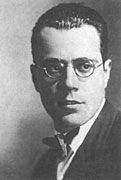
Roberto Juan Capurro was born in Buenos Aires, on August 12, 1903, to a family of mariners. He studies at the Escuela Nacional de Bellas Artes, where he graduates as National Professor of Artistic Drawing, in 1921.
In 1920, he sends his first piece of art to the Salón Nacional consisting of a molded head titled Caprichito (Little whim). He followed with regular exhibits at the municipal, provincial, national and international show rooms as well as Brazil, Bolivia and Italy. He is awarded the Third National Prize in 1926 and the Second Municipal Prize in 1929 and 1933. In 1940, he is awarded the First National Prize for his Estrella de mar (Sea star) and in1942 he is awarded the Gran Premio Adquisición for his Canción del mar (Song of the sea), a naked female where the emotional content and the painful atmosphere build up an expressive force in the composition, characteristics which are usually present in his pieces. His work is greeted with positive feedback from the critics. The favorable comments underline the harmony, plasticity and even certain “intentional deformities” which are not repetitive resources, as is pointed out in an article which appeared in El Pueblo newspaper in September, 1940.
In 1943, he holds an individual exhibit at the Galería Moderna in Buenos Aires and in 1947 he exhibits at the Casino de Mar del Plata. The following year he unveils predominantly marine themes in Mar del Plata - where the stone frequently used in his work is from. This city will house his Estrella de mar –a naked woman in bronze of natural size– and the Monumento al Pescador (Monument to the fisherman). Between 1949 and 1950, Capurro goes on a study trip to Brazil, Portugal, Italy and France. He works as a professor at the Escuela Superior de Bellas Artes at the University of La Plata and later on is named Honorary President ad honorem of the Museo de Bellas Artes de La Boca.
His work can be found in the following museums: Museo Nacional de Bellas Artes and the municipal museums in Buenos Aires, La Plata, Santa Fe, Paraná and Catamarca. Also, several of his pieces are housed in parks, public and private buildings. It is important to mention that Ponderación y carácter (Ponder and character), figures of stone, 3,5 meters high, are located in front of the Legislature Building in Buenos Aires; Paracelso Medicina Curativa, in front of the Facultad de Medicina and the Monumento al General San Martín, in Parque Lezama. A large number of his pieces belong to private collectors in Argentina, United States, Italy, Spain, Yugoslavia and Indonesia.
Known by his contemporaries as the “sculptor of the sea”, he dies in Buenos Aires, in September, 1971.